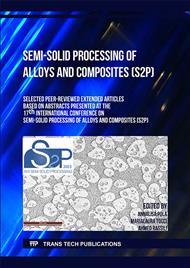[1]
A. C. Serrenho, J. B. Norman, and J. M. Allwood, "The impact of reducing car weight on global emissions: the future fleet in Great Britain," Philos. Trans. R. Soc. A Math. Phys. Eng. Sci., vol. 375, no. 2095, p.20160364, 2017.
DOI: 10.1098/rsta.2016.0364
Google Scholar
[2]
A. E. W. Jarfors, J. C. Zheng, L. Chen, and J. Yang, "Recent Advances in Commercial Application of the Rheometal Process in China and Europe," Solid State Phenom., vol. 285, p.405–410, 2019.
DOI: 10.4028/www.scientific.net/ssp.285.405
Google Scholar
[3]
G. Li, M. Luo, W. Y. Qu, H. X. Lu, X. G. Hu, and Q. Zhu, "Progress of Semi-Solid Processing of Alloys and Composites in China," Solid State Phenom., vol. 327, p.178–188, 2022.
DOI: 10.4028/www.scientific.net/ssp.327.178
Google Scholar
[4]
J. Campbell, Complete Casting Handbook Metal Casting Processes, Metallurgy, Techniques and Design, 2nd ed. Butterworth-Heinemann, 2015.
Google Scholar
[5]
A. E. W. Jarfors and S. Seifeddine, Metal casting. 2015.
Google Scholar
[6]
M. Payandeh, A. E. W. Jarfors, and M. Wessén, "Solidification Sequence and Evolution of Microstructure During Rheocasting of Four Al-Si-Mg-Fe Alloys with Low Si Content," Metall. Mater. Trans. A Phys. Metall. Mater. Sci., vol. 47, no. 3, p.1215–1228, 2015.
DOI: 10.1007/s11661-015-3290-9
Google Scholar
[7]
J. Santos, L. H. Kallien, A. E. W. Jarfors, and A. K. Dahle, "Influence of Grain Refinement on Slurry Formation and Surface Segregation in Semi-solid Al-7Si-0.3Mg Castings," Metall. Mater. Trans. A Phys. Metall. Mater. Sci., vol. 49, no. 10, p.4871–4883, 2018.
DOI: 10.1007/s11661-018-4787-9
Google Scholar
[8]
M. Payandeh, A. E. W. Jarfors, and M. Wessén, "Effect of Superheat on Melting Rate of EEM of Al Alloys during Stirring Using the RheoMetal Process," Solid State Phenom., vol. 192–193, p.392–397, 2012.
DOI: 10.4028/www.scientific.net/SSP.192-193.392
Google Scholar
[9]
M. Payandeh, M. H. Sabzevar, A. E. W. Jarfors, and M. Wessén, "Solidification and Re-melting Phenomena During Slurry Preparation Using the RheoMetalTM Process," Metall. Mater. Trans. B Process Metall. Mater. Process. Sci., vol. 48, no. 6, p.2836–2848, 2017.
DOI: 10.1007/s11663-017-1061-2
Google Scholar



